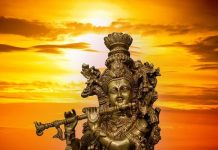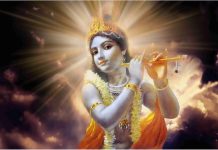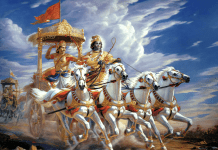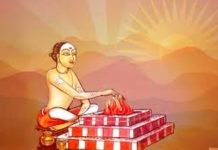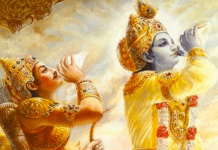Srimad Bhagavatam, Mahatmyam, Chapter One Sloka 20: Sapthaha sravane..
Sanaka munis once told Sage Narada that Srimad Bhagavatam is the ideal book that has the answer to all troubles and turmoil of the soul.
Who are Sanaka Munis?
Before getting into the story, Sanat Kumaras are four wonderful kids. They are a rare combination of innocence of kids and the wisdom of saints. In essence, when one gain’s true wisdom, be it in any field, one becomes innocent as kids. One tends to see the world around with innocence. One could say the Sanat Kumaras were child prodigies.
Now to the story. The Supreme Brahman created Brahmā and gave him all the spiritual knowledge to create the world. “Go and create the world, Oh Brahma,” the Lord said. Now, Brahma was clueless what to do. So, he contemplated or meditated for years trying to figure out what to do. Then, using his spiritual power, he created four kids hoping that they would go the four corners of the world and procreate. The four kids came to be known as Sanaka (ancient), Sanatana (joyful), Sanandana (eternal) and Sanatkumara (Ever Young).
The first thing they did was to disobey their father. Instead of procreating, they become sages because Brahma used only his spiritual powers to create them.
Brahma was mortified and livid that his four children were disobeying him. From a worldly point of view, their disobedience to the father was against dharma. This is probably why the Sanat Kumaras are not worshipped despite being embodiments of spirituality; they are only revered. Their names are not mentioned before any yagna. But because their disobedience was for a higher purpose, they were free from the after-effects of disobedience. The same was the case of Prahalada.
But those who disobey their fathers on materialistic grounds have to face the consequences. Brahma’s subsequent creations — the Manus — were an obedient lot because they had both a spiritual and materialistic journey to undertake.
The Sanat Kumaras represent Truth, Consciousness, Wisdom and Spirituality. With these powers they were enlightened souls. Their innocence is personified in their physical stature — they were always adorable kids, never grew to become adults. Hence, nothing could affect them.

Since they were always young, they are often referred to as Sanatkumaras or Sanatkumaradi munis.
There is another story on why they are perpetual kids. The four Kumaras is said to have learnt the Vedas at the age of four. They thus became great jnanis (learned beings), yogis and Siddhas (the perfect enlightened ones) — the first example of child prodigies.
Sanat Kumaras also appear in stories connected to Lord Shiva. It is said that initially there were only three Vedas — the Rig, Yajur and Sama. The story is of Sage Atharva — a Vedic sage who, along with Angiras, authored Atharvaveda. He is also said to have first instituted the fire-sacrifice or yagna. Atharva Muni approached Lord Shiva to get approval of his knowledge which he gathered from the universe using his divine powers. Lord Shiva, impressed by the knowledge enshrined in the book, blessed Sage Atharva saying that his work of deep knowledge would be called the ‘Atharvaveda’ and be part of the vedas.
READ MORE: Do not fear Kaliyuga when YOU are the Master
When this news reached the Sanat Kumaras, they were in doubt. With respect, they asked Lord Shiva for a debate, thus challenging his authority to certify the fourth veda. Goddess Saraswati was appointed as judge — the first female judge (call it breaking the glass ceiling). The Kumaras deliberately threw complicated questions to Lord Shiva and were confident of their victory. But Shiva, the Lord of all the supreme knowledge, answered each and every question with utmost calmness. Goddess Saraswathi declared Lord Siva victorious.
The Kumaras bowed their heads to Siva and accepted defeat and asked for forgiveness. Siva then lovingly looked at the kids, deeply impressed by their knowledge. That is a quality of Siva – in victory, recognise the merit of one who is defeated. The Kumaras accepted that Lord Siva had indeed taken the right decision and accepted the Artharva Veda as the fourth Veda.
There is a post-script to the story. The Sages then went to their brother Prajapati Daksha (a subsequent creation of Brahma), a bitter rival of Lord Shiva. Livid that his four brothers lost to Siva, he cursed them to remain as small children for ever. After that the four sages turned into small children. Since the sages were very learned and liberated souls, they thanked their brother for the curse because after becoming kids their urge and quest for learning more would increase.
The four Kumaras also figure in the Mahabharata. In Shanti Parva book of Mahabharata, the Kumaras give a discourse to the demon king Vritra and his guru – the sage Shukra.


























